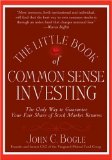 Last time I stopped by the library all of the books on my list were checked out. I was perusing the personal finance aisles and found another John C. Bogle book about index investing. “The Little Book of Common Sense Investing: The Only Way to Gaurantee Your Fair Share of Stock Market Returns” ended up being very similar to the previous Bogle book that I reviewed, “Common Sense on Mutual Funds”. There were a few key differences and a couple of nice additions at the end of the book.
Last time I stopped by the library all of the books on my list were checked out. I was perusing the personal finance aisles and found another John C. Bogle book about index investing. “The Little Book of Common Sense Investing: The Only Way to Gaurantee Your Fair Share of Stock Market Returns” ended up being very similar to the previous Bogle book that I reviewed, “Common Sense on Mutual Funds”. There were a few key differences and a couple of nice additions at the end of the book.
Similarities
Both of the books stress the importance of index investing. Index investing provides the maximum in diversification through purchasing the entire stock market and minimizing costs to provide average returns. The average returns are tax-efficient, don’t time the market and cost less, which leads to higher returns than the average actively managed fund with less risk.
Differences
The little book is much shorter and is an easier read. It’s as simple as that. You get most of the same information in less words and it’s easier to understand.
Interesting Addition - Asset Allocation
Bogle also includes a nice little section at the end titled - what should I do now? This section provides his personal advice as to how you should allocate your investments. Optimally, he said that you would split your holdings into an all-US stock market index portfolio and an all-US bond market index portfolio.
If you have the itch to try to actively manage your own funds, Bogle recommends using only 5% of your total investment assets for this purpose. This is supposed to be your fun money. As far as this fun money goes, he says you can pick individual stocks, some actively managed funds, ETFs that track particular sectors and commodity funds. He advises to stay away from closet index funds (index funds with high costs), ETFs if you are speculating (that is, not buying and holding) and hedge funds.
Bogle provides a few other pieces of information. As far as international investing he claims an all-US stock market index fund is already 30% invested in the foreign market as that is the percent of revenues and profits from US corporations. He recommends no more than 20% in the international scene. Bogle does not object to splitting your investments into segments that make your portfolio a little heavy in small-cap and value stocks.
For asset allocation with regards to stocks and bonds, Bogle recommends holding a bond position equal to your age, or your age minus ten percent. For bond holdings, he recommends the all-US-bond-market portfolio.
Conclusion
Although most of what I read was very similar to what I had previously read in Bogle’s other book, I really enjoyed reading a shorter, less dense book. Also, his opinions on asset allocation were very interesting and made the book worth the read all by itself. I definitely recommend this book for beginning investors. I don’t know how much I agree with him about his asset allocation advice, but I plan on reading up on asset allocation to really form my own opinions and this was a good start.
Related Articles- Links
- My Favorite Blog Articles of the Week
- 10 Steps to Retire a Millionaire
- Capital Gains, Losses and 2008 Tax Rates
- 11 Reasons to be Lazy and Average When Investing
- Is It Time To Get Back Into The Stock Market?
- What if History Doesn't Repeat Itself?
- I Have a Plasma TV, Am I Crazy?











One Response
Stay in touch with the conversation, subscribe to the RSS feed for comments on this post.
Nice writing. You are on my RSS reader now so I can read more from you down the road.
Allen Taylor